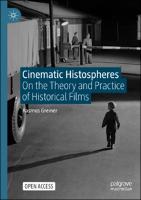Cinematic Histospheres
On the Theory and Practice of Historical Films
Abstract
In this Open Access book, film scholar Rasmus Greiner develops a theoretical model for the concept of the histosphere to refer to the “sphere” of a cinematically modelled, physically experienceable historical world. His analysis of practices of modelling and perceiving, immersion and empathy, experience and remembering, appropriation and refiguration, combine approaches from film studies, such as Vivian Sobchack’s phenomenology of film experience, with historiographic theories, such as Frank R. Ankersmit’s concept of historical experience. Building on this analysis, Greiner examines the spatial and temporal organization of historical films and presents discussions of mood and atmosphere, body and memory, and genre and historical consciousness. The analysis is based around three historical films, spanning six decades, that depict 1950s Germany: Helmut Käutner’s Sky Without Stars (1955), Jutta Brückner’s Years of Hunger (1980), and Sven Bohse’s three-part TV series Ku’damm 56 (2016).
Keywords
Screen Studies; History, general; Film Theory; Film Studies; History; Histosphere; Historical Film; Phenomenology of Film; Historical Experience; Audiovisual; Historical Worlds; Open Access; Performing arts; Historiography; Film history, theory & criticismDOI
10.1007/978-3-030-70590-9ISBN
9783030705909, 9783030705909Publisher
Springer NaturePublisher website
https://www.springernature.com/gp/products/booksPublication date and place
2021Imprint
Springer International PublishingClassification
Films, cinema
Television
History
Film history, theory or criticism


 Download
Download Web Shop
Web Shop